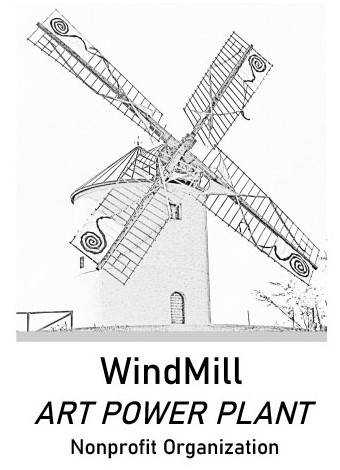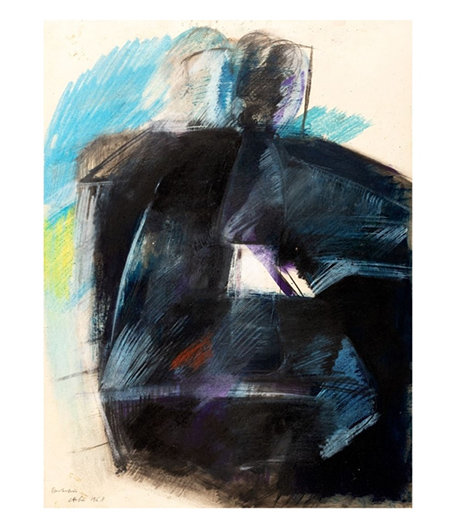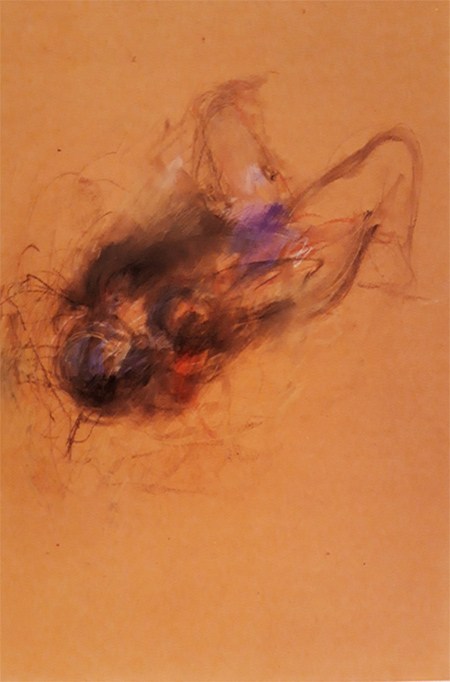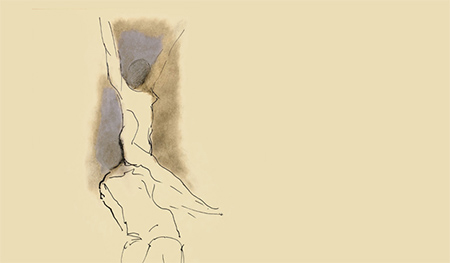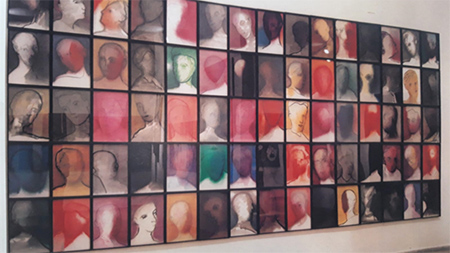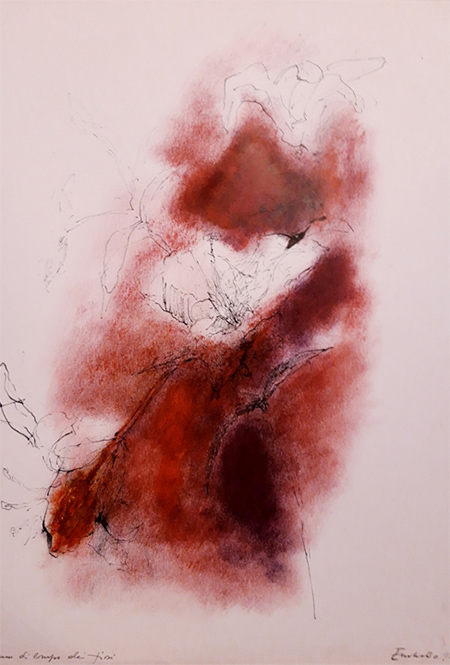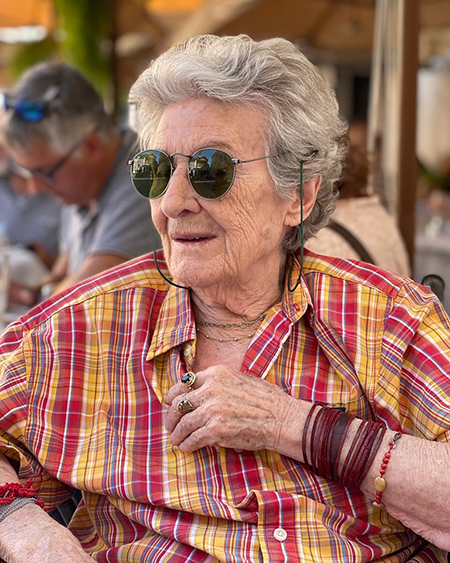
Marilù Eustachio
born in 1944
Italy
date of insertion W.A.D. 06/2022
Biography
Marilù Eustachio is an Italian artist who lives and works in Trastevere in Rome.
She was born in Merano, Alto Adige, on 15 August 1934. Merano is a small town set in the mountains, a landscape to which she is deeply attached. Since moving to Rome at the age of two, she has often returned there. This passion for the mountains and the love for her home territory are evident in her works.
“I was born in Merano in 1934 and until I was two years old I lived with a nanny in Caldaro, then I came to Rome. My first language was German.
Every year, for the long summer holidays, I went with my mother to Malles, in the Vinschgau Valley. I do not remember much about my early childhood. I was a shy, clumsy and inattentive child with a great love for cats and nature. I liked the woods, the streams, the small vegetable gardens, the barns.
Over the years my horizons widened, I began to move around the area on foot, by bicycle, by bus, whenever I could.
I was captured by the passion for the mountains, and with Vetter Adolf, who was a hunter of roe deer and ibex, I went on seemingly endless walks, to arrive, around noon, on a summit and then, before dusk, go back. I went up all the great peaks of the Vinschgau Valley: Otler, Cevedale, Similaun, Palla Bianca.
I also loved the cold, clear lakes where only we children could swim.
Over time I had become accustomed to going, alone, to the banks of the Adige River just to soak my feet or read or scribble.
Those were unforgettable solitary hours in a colourful nature full of scents.
I also went to the woods in search of mushrooms or to the Unicorn Hotel where I had a friend. So, I have always returned to Alto Adige and for the last thirty years I have spent my summers in Ums, a hamlet of Vols.
These holidays have been very different from those of my childhood and adolescence. In Ums, in the house of Cristina and Arnold Tribus, there formed a varied and extraordinary chosen family. Almost all my friends have come to Ums: Goffredo Parise, Piera degli Espositi, Francesca Sanvitale, Nadia Fusini, Alex Langer, the German feminist author Silvia Bovenschen, the German painter Sara Schumann, Franco Marcoaldi, Patrizia Cavalli, Baron Franchetti, Lillana Cavani, Gabriella Caramore, etc. etc. Now things have changed because I travel with difficulty, and because returning to places where you were once happy is never wise. I am at that age when we prefer to remember rather than experience, because the memory has an enchantment, a distance, a duration that reality cannot restore.
So, I am not so sure I will see my beloved South Tyrol again, but I often draw it, I prefigure it, I reconstruct it.”
In Rome Marilù obtained her classical high school diploma and continued her studies by winning a scholarship for a course for advertisers at the French Academy. Later she enrolled in the Faculty of Letters and Philosophy, “deepening her research on visual perception, which will form the basis of both her pictorial and photographic work.”
She taught painting for twenty years in remand centres and juvenile detention centres.
Despite having chosen painting as her favoured means of expression, Marilù Eustachio has always created works that seek to bring together a double vocation: a literary one and one related to the figurative arts. Her notebooks, for example, kept since childhood, are conceived by Eustachio as a process that allows one to “make a book by hand, one that can be enriched with images and writings, with notes and transcriptions.” According to art historian Peter Weiermair, Susan Sontag defined Eustachio’s work as “a gathering, accumulating, building and leaving traces.” Marilù Eustachio has also tried her hand at photography, and in this case with a focus on still life and objects she has come across.
Although always being in contact with numerous artists, intellectuals and authors among her friends, Eustachio has never wanted to be part of movements or groups, radically pursuing an ideal of independence and freedom both in her work and, consistently, in her life as an artist.
In the 1960s she was one of the founders of the collective of young artists, Il Girasole, together with Amadio, Checchi, Ciai, Capotondi, Gaetaniello, Guiotto, Patella, Sarnari, Vaiano and the critic Giorgio Di Genova. Her first solo exhibition “Eustachio” at the Galleria il Girasole dates from this period (1966).
In 1985 she began a series of studies on love, many of them dedicated to Emily Dickinson; these then merged into a book: Un Peso Viola, published by Eidos editions in 1990.
She exhibited in several galleries and museums in Italy. In particular, in Rome, for years she did so at Galleria Giulia and La Nuova Pesa. She always kept her ties to with her homeland, with several exhibitions at the Galleria il Sole and Spatia in Bolzano.
Since 1986 her notebooks have sprung from her love for reading and for books; since then she has also kept a sort of diary, her “notebooks,” in which she preserves sketches but also texts and quotes. To date she has filled about 300, where feelings, intuitions and experiences come together. Of different types, sizes and kinds of paper, the notebooks are characterized by a mix of techniques where figurative arts and literature alternate and merge, held together by the common thread of the diary method. Among the works and notebooks there is “a process of continuous osmosis,” the themes of painting are born and return among the pages of the notebooks, which testify to the processes of study and elaboration.
Soon the notebook became an “indispensable habit.” The diary form has always accompanied the artist, right from childhood she had the habit of transcribing into an exercise book poems and bits of stories, those she particularly loved, to save them in her memory and make them her own. Already in 1981 at the Galleria d’Arte Moderna in Rome, as part of the collective exhibition Arte e Critica 1981, curated by Marisa Volpi Orlandini, the artist exhibited a first form of diary: 365 drawings, one for each day of the year.
In 1988 her book Dai Taccuini was published by Le Parole Gelate, Rome, on the occasion of the exhibition The Labyrinth of Time; followed by Taccuini 1986-2005 edited by Peter Weiermair in 2005 at the Galleria d’Arte Moderna in Bologna; and the catalogue Taccuini published by Incontri Internazionali d’Arte, Graziella Lonardi Buontempo. In 2006 they were displayed at the exhibition Biblioteca Casanatense in Rome, and in 2016 Taccuini 1986-2016, edited by Andreas Hapkemeyer, was displayed at the Museion in Bolzano.
Eustachio began taking photographs at the age of six when her father gave her her first camera. From that moment this practice has coexisted with her activity as a painter. “The thousands of photographs taken over the years, by their nature of trace and testimony, are like the pages of her notebooks, […] they mark the rhythm of life,” Brunella Buscicchio Sherer.
In 1993 she published a book of photographs for Edizioni Arunda entitled Et in arcadia ego with writings by Arnold Tribus, Erich Erlacher and Silvia Renhart.
In 2019 she held her last photographic exhibition, in Bolzano at the Galleria Foto_forum, entitled Heimat 2.
Those who have written about the work of Marilù Eustachio
Rudolf Arnheim, Susan Sontag, Amelia Rosselli, Leonardo Sinisgalli, Lorenza Trucchi, Marisa Volpi, Giorgio Cortenova, Peter Weiermair, Guido Giuffrè, Gabriella Caramore, Alice Ceresa, Fabrizio D’Amico, Erri De Luca, Maurizio Fagiolo dell’Arco, Maria Silvia Farci, Nadia Fusini, Valerio Magrelli, Bruno Mantura, Franco Marcoaldi, Flavio Caroli, Giorgio Di Genova, Paolo Milano, Marina Miraglia, Achille Bonito Oliva, Goffredo Parise, Mario Quesada, Elisabetta Rasy, Domenico Rea, Giorgio Agamben, …
Some writings
“An art of what passes, around a reality that has already passed … leaving a draft or a spray of traces. Like the beat of red that lingers on the horizon of the desert for some minutes after the sun has set, or the thread, lemon-coloured, of urine on the snow. An art that tails reality, delicately following its semi-faded footsteps, tracing it from afar. From a distance without presumption.
A consciousness that aims at an ideal docility toward the real: ideally sensitive, ideally stubborn. An art that humbly copies, that draws with fidelity: Marilù Eustachio has taken many portraits from photographs. The image, a sign itself, is evanescent. An idea of art as a gathering, accumulating, building and leaving traces. And a covering of tracks: by giving them a strong glaze, by veiling them.”
Susan Sontag, An Art of What Passes, from the catalogue for the exhibition Diario per Immagini, Galleria Apatia, Milan, 1981
“[…] Marilù Eustachio seems constantly struggling with time. If time always works to steal reality, she always opposes it as if to want to save its traces, even be it in the form of a relic of a strenuous religion of life that, in its often brutal passage, still reserves unforgettable apparitions.”
Elisabetta Rasy, from Piccole Tracce del Tempo – Vent’anni di Vita in Taccuini di Marilù Eustachio, Corriere della Sera, 10-5-2006
“[…] a curious influence of the previous works on the later ones suggested that even the supposed “abstractions” hid, under a reticent surface, some readable memory of a world known to all, but denied to our sight by the jealousy with which a sensitive artist reacts to a world that is all too public. “
Rudolf Arnheim, from the catalogue of the exhibition Eustachio, Galleria dell’Ariete, Milan, 1979
“[…] then it is the colour and only the colour to conquer the intelligence and the wonderful shape of a flower, in which the nocturnal siege of sensations has been lifted and everything has been ecstatically composed in light and thought. As Marilù herself has written, sensations “emerge from the dark toward the light, from the indistinct to the distinct, from the absent to the present.” In this sense, colour is here intelligence and constructive reason. Provided that it is specified that intelligence is never separated from the imagination – that, as in Cavalcanti and in the stilnovists, Averroes’ unique intellect unites with individuals through their ghosts and their desires, even if these were to exhaust and perish in him. And it is here that Marilù feels at home, as in the papers that her hand has marked with the untranslatable German term that has always been so close to her heart: Heimat.”
Giorgio Agamben, The Intelligence of Colour, from the catalogue of the exhibition Heimat, Kunst Merano Arte, 2018
“The diary has been for everyone, and since its first invention, that intimate writing to which one delivers the most secret and fragile part of oneself, but also the most obstinate and visionary part. Marilù Eustachio has cultivated with great invention and quality this “backward” and reserved genre; she has given those hidden notebooks, which we all keep in forgotten drawers, a surplus of beauty and meaning that have transformed them from “confidences” into “works.” The diary was once called “the barometer of the soul,” and those of Marilù Eustachio in order to measure, with the desired precision, the variability and mobility of the soul, call for the concurrence of sketches, words, drawings and colours. Therefore, I believe that these notebooks are exciting and complex objects; not all of them can and should be read, some are “secret,” and this unrevealed reserve of meaning is like the potential that inflames and strengthens the whole work.”
Graziella Lonardi Buontempo, from the catalogue The Labyrinth of Time. Taccuini 1986-2005 edited by Perter Weiermair, Galleria d’Arte Moderna di Bologna, 2005
“Eustachio achieves a state of mind in which loneliness becomes tranquil and it seems that the sheets … a refined suffering that no longer needs consolation. This is how they turn into a kind of soft wax for the right footprints. The skeletal reference of the data lends itself to manipulations that are only apparently simple, and what seemed indecipherable even to the painter becomes true, explicit for everyone.”
Marisa Volpi Orlandini, from the catalogue Arte e Critica 1981, Galleria Nazionale D’Arte Moderna, Rome, 1981
Curriculum
Dai primi anni sessanta a oggi ha tenuto numerose mostre personali e ha partecipato a diverse rassegne e mostre collettive in Italia e
all’estero. Tra queste:
2019 Bolzano, Foto Forum, Heimat 2
2019 Pechino-Cina, Tsinghua Academy museum,”SILK ART YUN”
2018 Pechino-Cina, Mostra internazionale ,The Gongwangfu museum Pechino
2018 Mareno, Museo Kunst Meran Art, Heimat
2017 Roma, Accademia di Belle Arti di Roma,Famel Artists International Exhibition
2017 Roma, Biblioteca Vallicelliana
2017 Roma, Biblioteca Villa Pamphilj, “oli e disegni su carta”
2016 Bolzano, Museion di Bolzano, Taccuini 1986-2016
2016 Roma, Camera dei Deputati, Palazzo Montecitorio, “ Vo(L)to di Donna”
2016 Roma, Galleria La Nuova Pesa, “Dissolvenze”
2015 Roma, Chiesa di S.Lucia del Gonfalone, “Storia di un anno”
2014 Roma, Galleria Doozo, Mostra di fotografia ,”Maresole”
2013 Roma, MACRO, Ritratto di una citta’. Arte a Roma 1960-2001
2013 Roma, Galleria La Nuova Pesa, “ Di Luogo in luogo”
2012 Roma, Sala della Crociera, Ministero dei Beni Culturali
2011 Venezia, Padiglione Italia Biennale Venezia, “ Arte non e’ cosa nostra”
2009 Bergamo, Galleria Ceribelli, “Presenze, Assenze”
2008 Roma, Museo Hendrik C. Andersen ,“Autoritratti/Autobiografia”
2008 Roma, Museo Carlo Bilotti, “Mitografia”
2008 Roma, Museo di Roma in Trastevere, “Roma luogo della memoria, luogo della visione”
2007 Torino, Internazionale d’Arte Contemporanea, Artissima 13
2007 Roma, Spazio Blu, K. Ama Sutra
2006 Roma, Valentina Bonomo Arte Contemporanea, Grazie per una Volta
2006 Roma, Monserratoarte900, Ascolta uomo
2006 Roma, Galleria cortese &Lisanti, Donne d’arte
2006 Torino, Internazionale d’Arte Contemporanea, Artissima 12
2006 Roma, Biblioteca Casanatense, Taccuini 1986-2006
2005 Bologna, Galleria d’arte moderna, Taccuini 1986-2005
2005 Bolzano, Laurin Hotel, “ Alberi in Sequenza”
2005 Roma, Galleria Luxardo, Mostra di fotografia, “Immagini Sorprese”
2005 Roma, Galleria Giulia, Collettiva
2004 Cosenza, casa delle Culture, L’arte dei ciliegi. Omaggio a Cechov
2004 Roma, Villa Sgaravatti, Outart
2004 Roma, Festival Internazionale di fotografia, Istituto nazionale per la Grafica, Palazzo della
Calcografia, “La Dura Bellezza”
2003 Roma, Galleria Maniero, Quattro
2003 Roma, Maniero Associazione Culturale, “ 4 Artiste”
2003 Ancona, Mole Vanvitelliana, Carte di Artemisia
2003 Roma, Galleria A.A.M. Architettura Arte Moderna, On paper. Attraverso disegno
2003 Roma, Galleria Giulia, Cercaricerca
2003 Roma, Villa medici, Academie de France à Rome, Incontri… dalla collezione Gabriella Lonardi Buontempo
2002 Roma, Studio Angeletti, L’arte non è merce geneticamente modificata
2002 Galleria A.A.M. Architettura Arte Moderna, Tutti giù per terra
2002 Roma, Museo Hendrik C. Andersen, Amicizia e memoria
2002 Roma, Galleria Giulia, Nudi d’autore
2002 Roma, Galleria Giulia e Museo Laboratorio Arte Contemporanea, Arte e Scienza. Le biotecnologie nel dibattito scientifico e nell’immaginario
2002 Roma, Biblioteca Casanatense, Theke
2001 Termoli (CB), Galleria Civica d’Arte Contemporanea, Mail Art
2001 Roma, Galleria A.A.M. Architettura Arte Moderna, Oggetti smarriti e ritrovati
2001 Roma Galleria A. A. M. Architettura Arte moderna, Marilù Eustachio-Renato Mambor. Corrispondenze
2001 Roma, Galleria Giulia, Natura altrove
2001 Gala di Barcellona (ME), Museo della Mattonella d’Arte
2001 Roma, Politeama Gallery, Omaggio a Trilussa
2001 Roma, Galleria A..A.M. Architettura Arte Moderna, Cash &Carry: il magazzino d’arte
2000 Roma, Galleria Giulia, Epifania
2000 Roma, Galleria A.A.M. Architettura Arte Moderna, Microcosmi ideali
2000 Roma, Galleria Pio Monti, Della notte
2000 Napoli, Palazzo Reale, Cartoline per Napoli
1999 Roma, G alleria Giulia, “ Sembianze”
1999 Roma, Galleria Comunale d’Arte Moderna e Contemporanea, Lavori in corso 7
1999 Palazzo delle Esposizioni, Quadriennale Nazionale d’Arte. Proiezioni 2000. Lo spazio delle arti visive nella civiltà multimediale
1999 Roma. Politecnico Arte/Ankara, Istituto Italiano di Cultura/ Istanbul, Yanus Emre/ Rabat, Istituto Italiano di Cultura, Carissime nemiche
1999 Roma, Studio d’Arte Contemporanea Change, Effetto Domino
1998 Roma, Galleria dei Greci, Formato pocket
1998 Roma, Equilibri Precari, Poco più
1998 Roma, Galleria Nazionale d’Arte Moderna, Arte a Roma negli anni Sessanta. Una collezione, un dono
1998 Roma, Galleria Athena Arte, D x D
1998 Conegliano Veneto (TV), Palazzo Sarcinelli, Una donazione per un nuovo museo
1998 Roma, Galleria Il Segno, Il segno di diario
1998 Palermo, Orto Botanico/ Il Cairo, Istituto di Cultura, Palme d’autore
1997 Serravezza (LU), Palazzo Mediceo, Il Girasole trent ‘anni dopo
1997 Roma, Palazzo delle Esposizioni, Sandro Penna, poeta a Roma
1997 Roma, Galleria d’Arte Navona, Colori su Fonopoli
1996 Mirano (VE), Riviere Spazio d’Arte, Pagine in parete
1996 Lakeland (Florida, USA), Polk Museum of Art, Transiti italiani
1996, Roma Galleria Because I love, Le cadavre exquis
1996 Roma, Art Gallery Banchi Nuovi, L’arte è donna
1996 Comiso (RG), Galleria degli Archi, L’altra metà del cielo
1996 Roma, Gilda, 360′ proiezioni d’arte
1996 Roma, Liberamente, Incartati. Fantasie di cartone
1996 Sangemini (TR), Studio Watts, Le case del cuore
1995 Roma, Palazzo delle Esposizioni, La parola e lo sguardo
1995 Bologna, Forni Tendenze, Continuità del talento
1995 Bolzano, Parkhotel Laurin, Damen Salon
1995 Venezia, Scuola Internazionale di Grafica, Identità e differenza
1995 Beijing, Istituto Culturale dell’ambasciata Italiana e Wan Fung Gallery, Women and the Arts in Italy
1995 Bologna, Forni Tendenze. Figure della pittura. Arte in Italia 1956-1968
1995 Oderzo (TV), Palazzo Foscolo. Collettiva
1994 Roma, Centro culturale Virginia Wolf, Gruppo B
1994 Roma, Galleria Il Narciso, Il gioco della dama
1994 Roma, Galleria La Nuova Pesa, Mostra di fotografia
1994 Roma, Galleria capo de’ Fiori, Roma, o cara
1994 Bolzano, Galleria Spatia, 15 anni
1994 Roma, Galleria dell’oca, Per Goffredo Parise. Artisti
1994 Torrimpietra (RM), Centro Breccia, Solstizio
1994 Paris, Passage de Retz, Art- Energie
1994 Francavilla al Mare (CH), XLVI Premio Michetti. Storie di pittura
1993 Roma, Società Lunare, Figure del giorno e della notte
1993 Mantova Palazzo Ducale/ Stra (VE). Villa Pisani/ Praha, Istituto Culturale italiano, Guido, i’vorrei…
1993 Roma, Galleria la Nuova Pesa, Faccia a facce
1993 Beijing, Rassegna Internazionale della Cultura Italiana , Trasparenze dell’arte italiana sulla via della carta
1993 Spoleto, Ex Carcere del Santo Uffizio/ Pesaro, Palazzo Toschi Mosca, Straniati Stracci
1992 Roma, Galleria grafica dei Greci, Rara collezione di opere informali: 1959- 1990
1992 New York, The City University of New York, America/ Italy: A Visual Dialogues that Continues
1992 Firenze, Fortezza da Basso, Ipotesi per una collezione
1991 Roma, La Casa della Città, mostra di fotografia “La Casa di Vetro”, fotografie di 13 autori italiani
1991 Roma, Galleria il Narciso, Frammenti di memoria
1991 Roma, Galleria Rondanini, Percorsi ininterrotti dell’arte
1991 Roma, Casa della Città, La casa di vetro. Fotografie di tredici autori italiani
1991 Bolzano, Museo d’Arte Moderna, Beauty in difficult. Homage to Ezra Pound
1991 Roma, Galleria Eralov, Mostra di polaroid
1991 Roma, Circolo degli Artisti, Artae
1991 Bolzano, Galleria Spatia, Ex-libris
1991 Roma, Studio Sotis, Essenze
1991 Ponte di Piave(TV), Casa della Cultura Goffredo Parise, Omaggio a Goffredo Parise
1990 Innsbruck, Ferdinandeum, Tiroler Landesmuseum/Bolzano, Museo d’ Arte Moderna, Tirol von Aussen
1990 Venezia- Mirano mostra di fotografia, Barchessa di Villa XXV aprile
1990 Galleria Civica, Raccolta del disegno contemporaneo, acquisizioni 1990
1989 Milano, XXXI Biennale Nazionale d’Arte Città di Milano
1989 Bolzano, Galleria Spatia, Vienna-Vienna
1989 Roma, Galleria Gregory, Pittori di notte
1989 Reggio Emilia, Chiostri di San Domenico, Sala delle Carrozze, Figure e forme dell’immaginano femminile
1989 Roma, Galleria Arco di Rab, Ubi minor, ibi maior
1989 Narni, Auditorium San Domenico, Carta x carta
1987 Roma, Galleria Giulia, Collezione Privata
1987 Roma, Galleria Gregory, Cuore di pittore
1987 Roma, Galleria D’arte Ex Libris , “ intorno al tempo carte 1984-1987”
1986 Roma, palazzo dei Congressi, XI Quadriennale Nazionale d’Arte come scrittura
1986 Roma, Galleria Giulia, Quindici anni
1984 Roma, Opera Universitaria, Alternanze
1984 Cagliari, Arte Duchamp
1984 Roma, Palazzo Rivaldi, La macchina della memoria
1984 Bolzano, Galleria Spatia, 5 anni
1983 Udine, Opera Aperta. Rassegna d’Arte Contemporanea 1960-1980
1983 Roma, Centre Culturel Français, Romances sans Paroles
1982 Roma, Galleria Grafica dei Greci, EX-Libris
1982 Paris, Istituto Culturale Italiano, Expotition de Quatres Peintres Romaines
1982 Paris, Maison de la Culture de St- Etienne, Livres d’art et d’artistes
1981 Roma, Galleria Nazionale d’Arte Moderna, Arte e Critica 1981
1981 Baden- Baden, II Biennale della Grafica europea
1981 Roma, Libreria Giulia, La biblioteca di un principe eccentrico
1981 Roma, Libreria Giulia, La bella e la bestia
1979 Milano, Galleria Bergamini, L’altra satira
1979 Bolzano, Galleria il Sole, Mostra n. 100
1978 Roma, Centro Morandi, L’altra faccia della luna
1978 Roma, Libreria Giulia, A che serve un libro senza figure?
1978 Beirut, Esposizione Internazionale d’Arte
1978 Termoli, Premio Castello Svevo
1977 Roma, Galleria Giulia
1977 Firenze, Mater Maria
1977 Ravenna, Pinacoteca comunale, Segno-Identità
1977 Roma, Galleria dell’Oca
1976 Roma, Galleria il Segno
1976 Roma, Galleria Giulia
1976 Roma, Galleria la Nuova Pesa
1976 Milano, Palazzo della Permanente, Mostra del disegno e della piccola scultura
1975 Wien, Palais Paiffy, Der Mythos der Frau
1975 Verona, Galleria Ferrari, Proposta di sei artisti
1973 Milano, Galleria le Ore, XI Premio del Disegno
1973 Bologna, Museo Civico, Arte Contemporanea 1973
1972 Södertälje (Svezia), Museo Södertälje, Grafica Italiana
1971 Arezzo, Galleria Comunale d’Arte Moderna/Imola, Chiostri di san Domenico, Per copia conforme
1971 Capo d’Orlando (ME), Premio Capo d’Orlando
1969 Roma, Il Torcoliere Galleria e Stamperia d’Arte, “ studi su Giovanna d’Arco di Dreyer”
1968 Roma, Galleria Il Girasole
1968 Roma, Galleria L’Agrifoglio
1968 Livorno, Galleria d’Arte Contemporanea Il Minotauro
1967 Roma, Galleria Il Girasole, Autoverifica
1966 Milano, Galleria le Ore
1966 Spoleto, Collettiva Il Girasole
1965 Roma, Galleria Il Girasole
1965 Roma, Libreria ll Mondo
1965 Roma, V Rassegna delle Arti Figurative di Roma e del Lazio
1965 Roma/ Reggio Emilia/ Parma/ Ferrara, Prospettive
1964 Milano, Premio san Fedele
1964 Prato, Premio Città di Prato
1964 Paderno Dugnano (MI), Premio Paderno Dugnano
1963 Roma, IV Rassegna delle Arti Figurative di Roma e del Lazio
1963 Palermo, Premio Sicilia Industria
1963 Palermo- Tunisi, Mostra Nazionale del Piccolo Dipinto
1962 Recoaro Terme (VI), Biennale Nazionale del Disegno
1962 Gubbio (PG), Premio Gubbio
1961 San Marino, III Biennale Repubblica di San Marino
1961Marsala (TP), Premio Città di Marsala
1961 Roma, III Rassegna delle Arti Figurative di Roma e del Lazio
1959 Roma, VII Quadriennale Nazionale d’Arte
Figure
1963 – tecnica mista su cartoncino cm 70×50
L'inizio
1985 – dalla serie «studi sull’amore” pastello su carta – cm 100×70
Senza titolo
1994 – Inchiostro e olio su carta – cm 297×21
Repertorio
1997/99 – olio e pastello su carta – cm250x600 – 75 pezzi cm50x36 ciascuno
Lilium di campo de’ Fiori
1992 – Olio e inchiostro su carta – Cm 46×38
